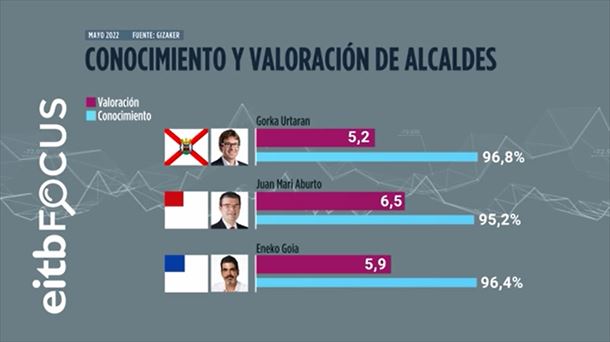EH Bildu would hold the second position and would be the force that achieved the largest increase in the percentage of votes, which would translate into one more councilor. PP and Elkarrekin Podemos would be the formations that would lose the most.
Euskaraz irakurri: EAJk Donostiako lehen indarra izatea lortuko luke, 2019an baino orderzkari bat gehiago eskuratuta
The PNV would be the formation with the most votes in San Sebastian in the municipal elections, managed to go from 10 to 11 councilors, and a 1.5% increase in the percentage of votes, from 35.8 to 37.3%.
This new wave of EITB FOCUS has been carried out when there is only one year left before the municipal and regional elections, which will take place on the last Sunday of May 2023. The regional elections survey will be published tomorrow and Wednesday, it is the turn to Navarre.
Like the PVV, EH Bildu would also bring in an alderman than in the previous election nomination, going from 6 to 7. Moreover, it would be the formation that would increase the support received in a larger proportion; it would get 3.3% more votes than in 2019, when it got 21.4% of the vote.
Voting Intent in San Sebastian
The PSE-EE would receive less supportfalling from 17.7% to 16.5% in percentage of the vote, although it could keep its representation, by 5
However, both the PP like Elkarrekin would lose Podemos one representative each, from three to two, with 2.3% and 2% fewer votes respectively than in 2019.

Distribution of councilors in San Sebastian
Rating
Eneko Goia has achieved a 5.9 out of 10 and 96.4% of the answers confirm that they know the mayor of San Sebastian.
In addition, 77% of the respondents approve of the leadership of the Eneko Goia team, with an average score of 5.9.

Mayors Review
View the results in Vitoria-Gasteiz here and the results in Bilbao here.
Methodology:
The methodology used for the preparation of this study is quantitative, using the telephone interview technique. This research technique makes it possible to respond to all proposed objectives and to obtain results with a maximum validity and reliability with which to act effectively.
The population that makes up the research universe consists of the group of people older than or equal to 18 years old, residents of the CAV, who carry out the fieldwork during the days from 5 to 12 March. A stratified sample has been carried out, with determination proportional to the quota, also using quantitative method.
Data sheet:
1,750 inhabitants of the BAC (400 in Vitoria-Gasteiz and 150 in the rest of Araba; 400 in Bilbao and 200 in the rest of Bizkaia; 400 in Donostia-San Sebastián and 200 in the rest of Gipuzkoa). Em= ±2.34%, 95% confidence level, p=q=0.5, for CAV data, ±4.18% for Araba data, ±4.0 0% for Bizkaia data, ±4.00 % for Gipuzkoa data, ±4.90% for Vitoria-Gasteiz data, ±4.90% for Bilbao data and ±4.90% for Donostia-San Sebastián data.
Random sample stratified by historical area, municipality, gender and age. 26.9% of the surveys were conducted in Basque and the remaining 73.1% in Spanish. Total results weighted by population size of the surveyed municipalities. The fieldwork was conducted from 5 to 12 May 2022 by means of a telephone interview. The average length of the survey was 5.31′, with the shortest survey being 4′ and the longest 18′.
(function(d, s, id) {
var js, fjs = d.getElementsByTagName(s)[0];
if (d.getElementById(id)) return;
js = d.createElement(s); js.id = id;
js.src = “//connect.facebook.net/es_ES/sdk.js#xfbml=1&version=v2.8”;
fjs.parentNode.insertBefore(js, fjs);
}(document, ‘script’, ‘facebook-jssdk’));
Source: EITB
I’m Wayne Wickman, a professional journalist and author for Today Times Live. My specialty is covering global news and current events, offering readers a unique perspective on the world’s most pressing issues. I’m passionate about storytelling and helping people stay informed on the goings-on of our planet.



